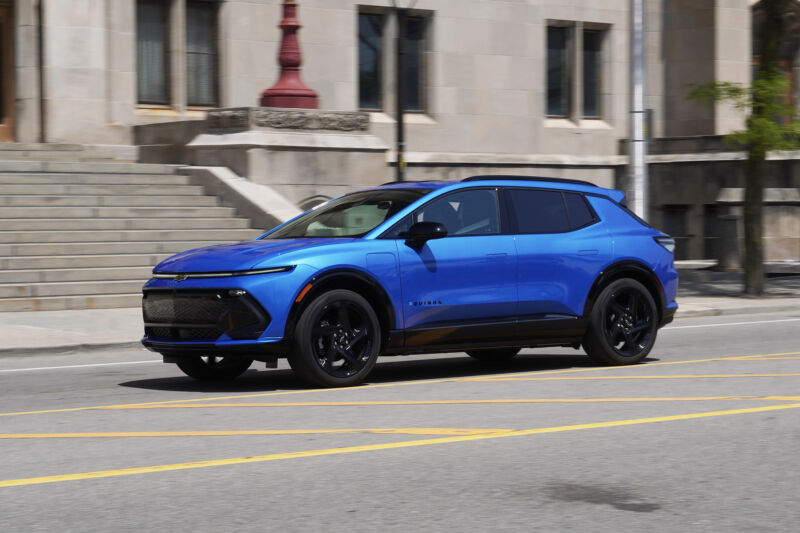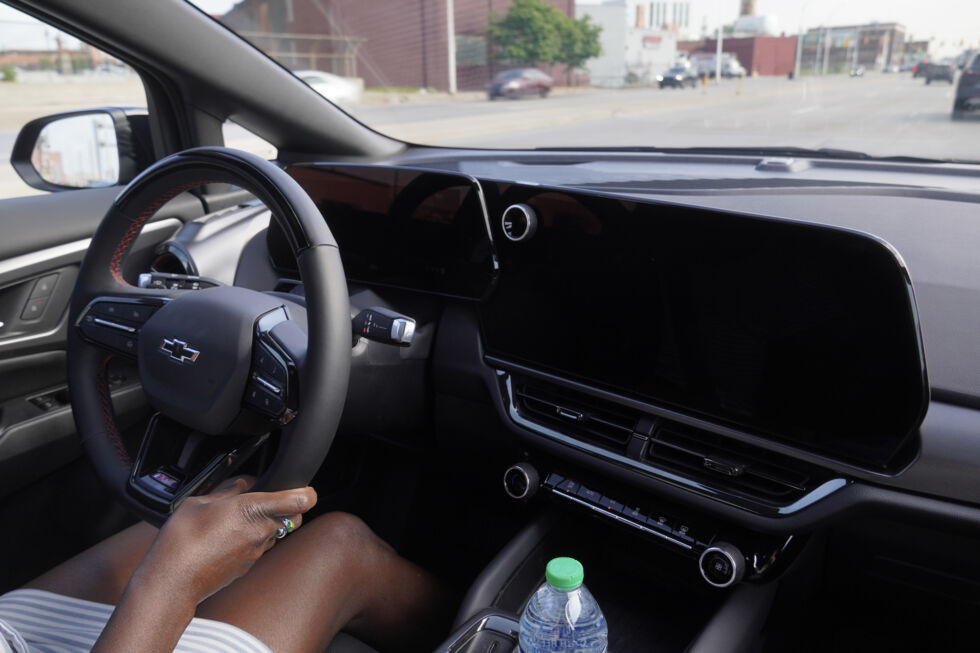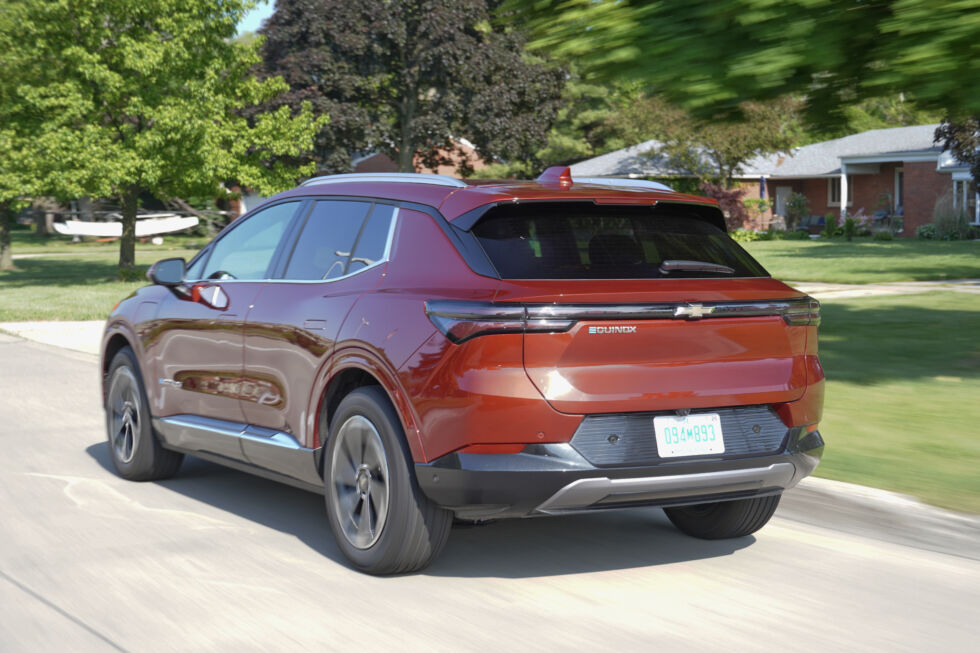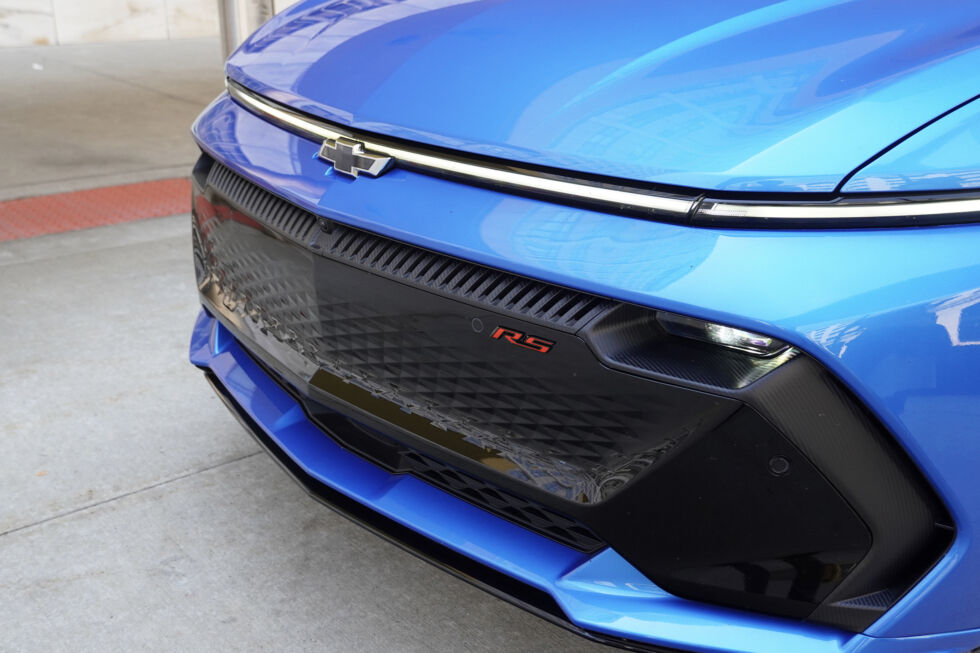GM’s latest Ultium-based EV is ready for the road.

A new entry-level EV from General Motors hits the market this year bearing the name Equinox, but other than nomenclature, this Chevy is not at all related to the current internal-combustion compact crossover. Instead, the new Equinox EV rides on the smallest iteration of GM’s Ultium platform until the Bolt reboots with a new (lithium iron phosphate) Ultium battery pack.
The Equinox EV shares its chassis with the forthcoming Cadillac Optiq but aims instead to hit the market as cheaply as possible and significantly undercut Tesla’s Model Y. Deliveries will start later this year with the LT trim level, which has a starting MSRP of $34,995. Eager to prove what it no doubt hopes will be the new cash-cow EV’s bona fides, Chevrolet invited media to Detroit to drive a fleet of Equinoxes in various trim levels.
On paper, the Equinox’s stats look fairly solid. A smallish 85 kWh battery is sufficient for an EPA range estimate of 319 miles (513 km) for the front-wheel-drive base model. Output for the single motor clocks in at a respectable 213 hp (159 kW) and 236 lb-ft (320 Nm) of torque. Perhaps the only downside appears to be a max DC fast-charging rate of 150 kW, though thanks to the battery’s overall capacity, the Equinox should still add 77 miles (124 km) of range in about 10 minutes.
- Chevrolet brought along both RS (pictured) and LT trims of the Equinox EV. Michael Teo Van Runkle
- The shape shares little with the gasoline-powered Equinox. Michael Teo Van Runkle
- The Equinox EV is 191 inches (4,851 mm) long, 77 inches (1.956 mm) wide, and 65 inches (1,651 mm) tall. Michael Teo Van Runkle
- The 3RS can be specced with a rather bold interior. Chevrolet
- A look at the back seat. This stormtrooper-spec interior is available with the 3LT. Chevrolet
- There’s 26.4 cubic feet (748 L) of storage space with the rear seats in use, or 57.2 cubic feet (1,620 L) with the rear seats folded flat. Chevrolet

What’s the single-motor version like on the road?
From behind the wheel, I expected the FWD Equinox’s less-than-overwhelming power figures to result in sluggish acceleration. Luckily, instantaneously available grunt can produce just enough pep to cause a bit of torque steer, and I kept up with traffic without concern. Harder pulls above 45 mph (72 km/h) seem blunted, though—perhaps to maximize range.
In typical Ultium fashion, the steering can be best described as vague-ish, which Chevy’s increasingly thick-rimmed steering wheels don’t exactly help. But the Equinox never tries to play at sports car ambitions. And on Detroit’s battered roadways, the suspension runs the full gamut from smooth to stiff, depending on speed and driving style.
Keep things easy, and the Equinox treads lightly. Push harder or shift the battery pack’s mass aggressively over two wheels (via acceleration, braking, or cornering) and the dampers appear to struggle a bit. Jumping between test vehicles all day, I noticed a difference between the 19-inch and optional 21-inch wheel-and-tire combos. Making the right choice will come down to desired performance and, really, what region customers live in and how the local roads fare.

Real-world range matters most in a commuter car, and the Equinox performed admirably, if not as well as the Silverado fleet also on hand in Detroit. For one vehicle I tracked, I used 86 miles (138 km) of claimed range to drive 78 miles (126 km), with the air conditioning blasting on a hot day in a black car, and mostly at highway speeds, where larger EVs with upright profiles—and therefore a larger frontal area—tend to struggle.
ARS VIDEO
How Scientists Respond to Science Deniers
Now add a second motor
Engineers mingled around to discuss the Equinox, and one explained the all-wheel-drive variant’s second motor as more of a helper. The permanent-magnet, bar-wound front motor provides most of the motivation, while the rear induction motor with no magnet can either contribute to traction and acceleration or disconnect to maximize range.
The description reminded me of the all-wheel-drive Prius and Rav4 drivetrain, but in reality, with far more juice available—288 hp (215 kW) and 333 lb-ft (450 Nm) of torque—the AWD Equinox EV wakes up noticeably. Range drops a fair amount, to just 285 miles (458 km), but for me, the difference in off-the-line shove and overtaking speeds makes for a worthy trade-off.
The Equinox EV shares only a name with its ICE sibling, and the exterior styling sets the electric apart in a big way. Strikingly less bulbous and bland than the gas-powered version, the new design adds a hint of sleekness to the model line without trending too aggressively toward a futuristic aesthetic that hesitant EV buyers might avoid. The interior, on the other hand, felt very familiar thanks to a 17.7-inch infotainment system shared with the Traverse and Silverado, plus switchgear and buttons borrowed from plenty of other GM models.

The Equinox EV never pretends to be a premium car, and that’s fine, though I cannot agree with the decision to skip a physical start button (at the very least) in favor of a widget on the touchscreen that turns the car off.
One small glitch
Speaking of screens and turning off, I did experience one concerning moment when both the infotainment and gauge cluster displays went entirely black.
After maybe 20 seconds, a warning text appeared on the infotainment screen indicating that it was booting back up, which took about another minute by my estimate. I lost all nav functions during this time but luckily knew my general route and kept glued to the other cars in our convoy ahead. The gauge cluster was a bit more concerning to see switched off, but it flickered back to life maybe 20 seconds before the infotainment screen.
To be clear, nothing similar happened for the rest of the day in the Equinox, nor the next day with the Silverado EV. And I never heard from any other of the scores of journalists who visited Detroit over the week of test drives that anyone else experienced either screen turning off. One explanation for the fault suggested that Android Automotive OS might be the root cause, entirely isolated from the rest of the car’s software.
Obviously, flashbacks to the whole Blazer EV fiasco danced through my mind, but in a follow-up later, GM told me: “Software systems can sometimes freeze or become overwhelmed by too many quick inputs. In the rare occurrence where this happens, we’ve engineered our infotainment system to automatically restart, a process that generally takes around less than a minute. The screen provides important information, and we don’t want to make a customer wonder whether they need to pull over or restart the vehicle for minor and normal software behaviors.”

Still a great deal
Hopefully, Google and GM can sort out the issue, because when deliveries of the base model begin at the end of the year, the Equinox EV may cost as little as $27,495 for customers eligible for rebates and incentives. (The trims available at launch are significantly more expensive, starting at $43,295.) If so, this little electric crossover makes a solid case as being the best possible use case of the Ultium platform: Give me range, as little weight to haul around as possible, (ahem, Silverado and Hummer EVs), and a bargain price point. Roomy in the front seats, the back row, and cargo area, the Equinox EV pairs utility with range just about perfectly for a daily commuter EV.




